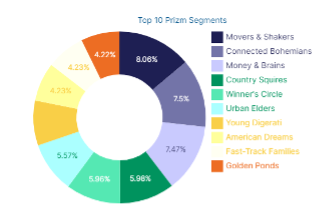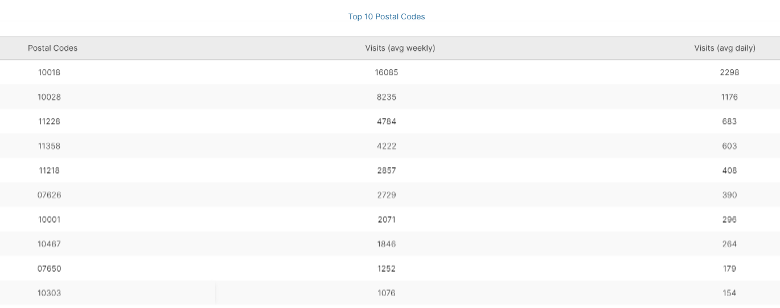Places Methodology
Quantifying visitation to a location is critical for a variety of businesses including retailers, travel and tourism, city governments, and media companies. Understanding who is visiting a venue, how long they are staying, the neighborhoods they live in, how often they visit, and what they like to buy is where Motionworks can transform data into valuable business insights with our suite of Placecast™ products.
Placecast™ provides Motionworks' Population Intelligence at places and regions.
Motionworks Places include large locations such as airports, movie theaters, universities, and shopping malls. Motionworks Places may also consist of smaller venues such as gas stations, convenience stores, and fast-food restaurants nested inside of a mall.
Motionworks Regions are bigger locations and geographies, such as beaches, parks, business districts, zip codes, counties, states, and DMAs. Customers can gain insights on custom regions of any shape or size.
How we work with places
Motionworks Placecast™ suite of products provides historical and near-real time data on the weekly activity history of places and regions from the beginning of 2019 to present.

These insights can be analyzed by day type as well as by hour of the day.


The data are updated weekly with a 15-day lag time to ensure data maturity.
Audience Insights
Placecast™ delivers in-depth profiling information on the types of people who recently visited a place or region. This includes information on standard demographics such as age, income, and race.

In addition to those standard demographics, Placecast™ has information on thousands of audience segments such as brand preferences, intent to purchase, media consumption, political affiliation, banking, and more.

For more information on the available segments, please review the Motionworks Population Segments Library.
Origin Information
In addition to insights into what kind of people are visiting a location, Placecast™ provides analytics into the neighborhood in which visitors live. This data is anonymously aggregated to zip codes, counties, CBSAs, DMAs, or state so that users can understand which areas are contributing the most visitation to their venue to optimize marketing, site selection, competitive conquesting, and more.

Activity Types
People may be visiting a location for a variety of reasons. For example, someone may spend an hour in a mall shopping. Another person may only be in the location for a few minutes to drop off their spouse. As a result, providing a simple “visits” count may inflate the number of people who were spending meaningful time in a venue.
Motionworks has established normative dwell thresholds by venue type to determine what constitutes an actual “visit” versus what may be a drop off or someone simply passing by.
In order to differentiate, Motionworks buckets the activities into several categories:
- Visits - A visit is an activity with a measured dwell time at the place greater than or equal to the activities dwell threshold.
- Dropoffs - A dropoff is an activity with a measured dwell time at the place less than the activities dwell threshold.
- Passbys – A passby is someone who was captured at a venue but did not dwell in that venue – resulting in zero dwell time.
- Stays – A stay is a visit that last overnight.
Unique Visits
Placecast™ provides visits two ways:
- in aggregate – which counts every visit in a given week, regardless of whether that visit is the same person, and
- unique visits – which only counts each person once per week – regardless of if they’ve come to that location multiple times
In conjunction with the above, Motionworks provides the average frequency of visits for individuals that appear multiple times in a venue in a given week.
To avoid skewing this average, Motionworks excludes individuals who live or work in the block group associated with the target venue from this metric.
Dwell Time
As stated above, dwell time is a crucial factor in determining whether an individual is actually visiting a venue or just passing by. It can also be a useful insight into understanding how long individuals visit a specific venue or region.
Placecast™ provides average dwell time for Motionworks Places and Regions. To avoid skewing the dwell time, Motionworks excludes individuals who live or work in the block group associated with the target venue.
Privacy
Motionworks is committed to providing insights in an anonymized, aggregated, and privacy-compliant way across all our solutions. Motionworks data do not provide insights into individual behaviors or the behaviors of individual devices and cannot be reverse-engineered or manipulated to provide such information. We do not share information containing unique device identifiers with any third parties.
In certain cases, specific places or groups of places may be effected by privacy regulations in various jurisdictions that restrict how data about those places or place types can be collected and shared. In these cases, Motionworks will always comply with the relevant regulations and may restrict or generalize data when needed for compliance. Additionally, data providers that are used by Motionworks could be under similar circumstances that restrict their ability to provide source data for these places or place types.
Precision of Estimates
All the Placecast™ metrics, visits, occupancy, dwell time, and others, are the result of sophisticated and complex data pipelines that are processing large amounts of raw data through time. Further breaking these metrics into insights about trade areas, demographics, and consumer behaviors only adds to the complexity of this data. These metrics rely on a series of independent, but interrelated methods that lead to a Motionworks data release.
Number Rounding
These methods typically rely on mathematical methods that use floating point (i.e. decimal or continuous) numbers. As a result, the estimates have fractional visits, which have been rounded to two decimal places for user convenience and reduced storage cost. These estimates can be rounded to whole visits (i.e. integers) if desired, but the subsegments may not perfectly sum to the totals and the estimates across metrics may not perfectly match as well. Nevertheless, rounding the estimates produces numbers that nearly align and can be considered a reasonable use.
Estimation Consistency
Motionworks is creating estimations of place activity based on data from direct observations. As a result places can be estimated independently or as part of a group of places. Making estimations based on groups is especially helpful when the amount of observed data is small and so it is either difficult or not possible to estimate. As a result, there are case where estimates may not align, such as when places nest within each other (like all places within a downtown office building, or all places within a shopping area complex including the parking area), for similar places (such as quick serve chain restaurants) in similar environments (such as within shopping malls), or across time and/or seasons (such as when special weather events occur). We are aware of cases when more consistent results are desired, and so we are constantly making improvements to our methods with this in mind.
Additional Methods
More information on Motionworks Places, and our Placecast™ Suite of Products can be found at:
Updated about 2 months ago
